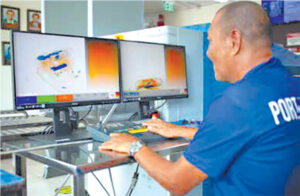Like every other sector of the economy, digitizing port operations is crucial to helping keep transnational trading and infrastructures in pace with global modernization. Not only does this integration improve economic performance by providing more efficient services but also promotes sustainability.
Additionally, digitizing port operations allow predictive maintenance, enabling ports to respond better to urgent disruptions such as delays due to bad weather. By allowing operators and policy makers to immediately adapt to emergency, this helps minimize downtime while communicating to stakeholders in a short amount of time.
Concerning the environment, digitalization operations help businesses cut their emissions and energy use by allowing operators to monitor environmental performance and energy use. As more nations demand lower carbon logistics, ports are able to have cleaner operations and comply to environmental regulations while reducing greenhouse gas emissions and carbon footprint, protecting marine life. Modernization and digitalization not only improve existing systems, but these strategic enhancements also create a more responsible and environmentally conscious trade and tourism.
As it marks its 51st year, the Philippine Ports Authority (PPA) keeps up with the rest of the world’s modernization by ramping up its digital operations towards an improved port infrastructure.
With global trade and tourism expanding ceaselessly, the PPA puts major emphasis on accessibility. Significant regional initiatives were exhibited: the completion of a cruise ship port in Surigao del Norte; the construction of new wharves and port operational areas in Batangas, Bohol, and Misamis Oriental to improve vessel accommodation and cargo handling; and the upgrading of the general cargo berth in Davao for amplifying trade and logistics.
These initiatives will allow ports to handle much larger capacity carriers. At the same time, the said improvements are expected to enhance efficiency by ensuring connectivity, and making ports and cruise stops a good experience for tourists and clients. These upgrades will also benefit the inter-relatedness of global trade and tourism as the PPA is sought to meet international standards and demands, accommodating a diverse set of vessel types.
Additionally, as the PPA is looking forward to improving their regulatory process, security measures were taken with regards to the International Ship and Port Facility Security (ISPFS) Code. This is intended to attract private sectors to invest in modern container terminals and cargo handling. Furthermore, in modernizing passenger and cruise terminals, the agency would expand infrastructures such as key hubs and Roll-on, Roll-off (RoRo) networks.
One of the agency’s testaments of progress is the 25-year concession agreement awarded by the PPA to the International Container Terminal Services, Inc. for upgrading the Visayas Container Terminal in Iloilo. While the upgrade kick-started with two mobile harbor cranes launched last Oct. 9, the upgrade will also include IT system upgrades, alongside additional cargo equipment and enhanced terminal facilities. Aligned with the agency’s commitment for creating modern, sustainable, and resilient port facilities, the upgraded terminal is set to significantly improve regulatory operations, as evidenced by a rise of 16% in foreign vessel arrivals and a huge upsurge of 79% foreign cargo volume from April to August 2024.
“This is our goal for the ports managed by the PPA: to create modern, sustainable, and resilient port infrastructure and facilities, as well as to provide services that meet the needs of the public and other stakeholders, ensuring that port operations adhere to global best practices,” PPA General Manager Jay Daniel R. Santiago said.
The agency is also commited to better public engagement and data-driven service within digital spaces, as shown by initiatives such as the Online Real Estate Management System (OREMS), designed to modernize the agency’s monitoring system in managing their collection of properties; the Private Port Electronic Filing System (PPEFS), wherein clients can submit their private port applications online with ease; and the transition of the integrated Electronic Accreditation System (EAS) and Electronic Permit Management System (EPMS), which ensures accreditation and permitting processes remain efficient and protected against cyber threats.
“As trade volumes grow and the demand for seamless logistics intensifies, the PPA utilizes technology to streamline port management and fortify data security,” the agency wrote in its Annual Report for 2024.
Throughout five decades, not only did the PPA impose projects for trade to be functional. They have also been going with the flow in terms of modernization and technological advancements in the name of progress.
“With a clear vision and commitment, we will continue shaping the future of our country’s maritime industry, ensuring our ports remain vital enablers of economic prosperity,” Mr. Santiago previously said. — Krystal Anjela H. Gamboa
